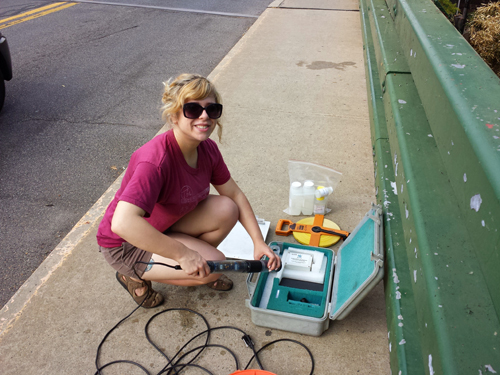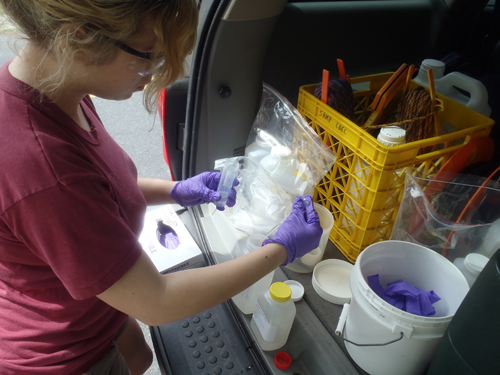Delaware River Basin Commission
Delaware • New Jersey • Pennsylvania
New York • United States of America
Delaware • New Jersey • Pennsylvania
New York • United States of America
DRBC's Summer Water Quality Monitoring Season Begins
DRBC's summer 2015 water quality monitoring efforts are underway, and staff are and will be keeping busy in the field this season sampling the Delaware River and various tributaries to support programs that include the following:
- Scenic Rivers Monitoring Program: A partner effort by DRBC and the National Park Service to assess whether existing water quality is being maintained in Special Protection Waters. Close to 60 sites are sampled between May and September and analyzed for nutrients, dissolved oxygen, and other conventional pollutants. Learn more by clicking here.
- Delaware River Biomonitoring Program: This DRBC program assesses ecosystem health and biological water quality criteria in the non-tidal Delaware River. Between August and September, macroinvertebrate (aquatic bugs) and periphyton (alga) samples are collected at 25 sites. Learn more by clicking here.
- Delaware Estuary Boat Run Monitoring Program: Initiated in 1967, this effort is one of the longest running monitoring programs in the world. Each year from April to October, DRBC contracts with the Delaware Dept. of Natural Resources and Environmental Control (DE DNREC) to collect water samples at 22 sites in the Delaware Estuary from the head of tide at Trenton, N.J. to the mouth of the Delaware Bay. Learn more by clicking here.
- Periodic Maintenance of HOBO Continuous Conductivity Monitors: DRBC currently has six of these meters deployed in the upper Delaware watershed to collect continuous water quality data that will provide a better understanding of baseline conductivity and temperature ranges over a variety of flows and conditions. These monitors require periodic maintenance and data downloads, which will continue during this monitoring season. Learn more by clicking here.
- Fish Tissue Monitoring: DRBC periodically samples fish tissue of resident fish species in the non-tidal and tidal portions of the main stem Delaware River. In the non-tidal portion, samples of smallmouth bass and white sucker are collected at three locations, and, in the tidal portion, samples of channel catfish and white perch are collected at five locations. The samples are analyzed for PCBs and other chemicals, as well as metals. Learn more by clicking here.
- Ambient Water Monitoring for PCBs: In support of the PCB TMDLs for the Delaware Estuary and Bay, DRBC staff will collect ambient water samples to provide data on PCB concentrations in the tidal portions of the Delaware River. Learn more by clicking here.
- Ambient Toxicity Monitoring with DE DNREC: In 2015, DRBC monitoring staff will collaborate with DE DNREC in their Watershed Approach to Toxics Assessment and Restoration (WATAR) for the Christina River Watershed, collecting samples for ambient water toxicity. Learn more by visiting http://www.dnrec.delaware.gov/dwhs/SIRB/Pages/WATAR.aspx.
The commission uses a multi-faceted strategy to water quality regulation, and a key part of this strategy are DRBC's monitoring programs. These monitoring efforts are important because water resources cannot be properly managed if they are not measured. DRBC's monitoring programs help to protect and restore water quality in the basin by providing a mechanism to evaluate how water quality criteria are being met and allow for data to be assessed.
Commission Member Links:
Delaware |
New Jersey |
Pennsylvania |
New York |
United States
Copyright © Delaware River Basin Commission,
P.O. Box 7360, West Trenton, NJ 08628-0360
Phone (609)883-9500; Fax (609)883-9522
Thanks to NJ for hosting the DRBC website
Copyright © Delaware River Basin Commission,
P.O. Box 7360, West Trenton, NJ 08628-0360
Phone (609)883-9500; Fax (609)883-9522
Thanks to NJ for hosting the DRBC website
Last Modified: 06/30/2015



